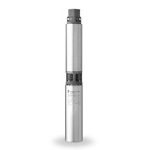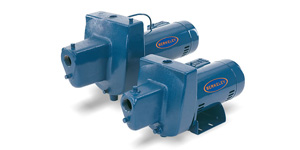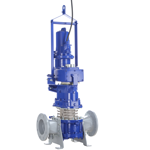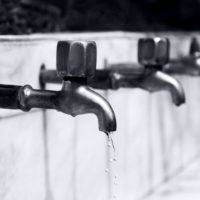Well Pumps:
Well pumps are a centrifugal, submersible type of pump used for bringing underground water up to the surface for domestic use. They can consist of one or several “stages” depending on the well depth and desired discharge pressure. Electrically powered the motor is typically on the bottom of the pump with the suction in the middle and the water is pumped upwards through the impeller(s) and upwards toward the surface.
 Submersible Pumps:
Submersible Pumps: 
Submersible pumps are much more efficient than above-ground pumps. Above-ground pumps work by pulling water up from beneath the surface, and they often suffer from a problem called cavitation. Cavitation can cause damage to the internal parts of an above-ground water pump, and after a while it will need to be repaired or replaced. Submersible pumps don’t suffer from cavitation, and experience fewer mechanical problems than above-ground pumps. They also need a lot less energy to push water upward then an above-ground pump needs to “pull” water from below. Submersible pumps use centrifugal force to create pressure that then forces water upward.
Jet Pumps: 
Oftentimes when a small, shallow well is involved, a jet pump is the best solution. Jet pumps rely on atmospheric pressure to function, and as a result, they are typically only used for wells that are no deeper than 25 feet. Jet pumps work by creating a vacuum. They force water through a small opening, called a jet, which creates a pressure imbalance. The pressure imbalance creates a suction force that “pulls” water up to the surface.
 Centrifugal Pumps:
Centrifugal Pumps:
A centrifugal pump is a rotodynamic pump that uses a rotating impeller to increase the velocity of a fluid. Centrifugal pumps are commonly used to move liquids through a piping system. The fluid enters the pump impeller along or near to the rotating axis and is accelerated by the impeller, flowing radially outward into a diffuser or volute chamber, from where it exits into the downstream piping system. A centrifugal pump works by the conversion of the rotational kinetic energy, typically from an electric motor or turbine, to an increased static fluid pressure. The rotation of the pump impeller imparts kinetic energy to the fluid as it is drawn in from the impeller eye (centre) and is forced outward through the impeller vanes to the periphery. As the fluid exits the impeller, the fluid kinetic energy (velocity) is then converted to (static) pressure due to the change in area the fluid experiences in the volute section. Typically the volute shape of the pump casing (increasing in volume), or the diffuser vanes (which serve to slow the fluid, converting to kinetic energy in to flow work) are responsible for the energy conversion. The energy conversion results in an increased pressure on the downstream side of the pump, causing flow.
Grinder Pumps: 
A grinder pump is a waste management device. Waste from water-using household appliances (toilets, bathtubs, washing machines, etc.) flows through the home’s pipes into the grinder pump’s holding tank. Once the waste inside the tank reaches a certain level, the pump will turn on, grind the waste into a fine slurry, and pump it to the central sewer system.
Chopper Pumps:
A chopper pump is a centrifugal pump, which is equipped with a cutting system to facilitate chopping/maceration of solids that are present in the pumped liquid. The main advantage of this type of pump is that it prevents clogging of the pump itself and of the adjacent piping, as all the solids and stringy materials are macerated by the chopping system. Chopper pumps exist in various configurations, including submersible and dry-installed design and they are typically equipped with an electric motor to run the impeller and to provide torque for the chopping system. Due to its high solids handling capabilities, the chopper pump is often used for pumping sewage, sludge, manure slurries, and other liquids that contain large or tough solids.
Variable-Frequency Drive:
A variable-frequency drive (VFD) is a system for controlling the rotational speed of an alternating current (AC) electric motor by controlling the frequency of the electrical power supplied to the motor. A variable frequency drive is a specific type of adjustable-speed drive. Variable-frequency drives are also known as adjustable-frequency drives (AFD), variable-speed drives (VSD), AC drives, microdrives or inverter drives. Since the voltage is varied along with frequency, these are sometimes also called VVVF (variable voltage variable frequency) drives. Variable-frequency drives are widely used. For example, in water booster stations, pump speed is controlled by the VFD based on system demand.
Pressure Tanks:
Pressure tanks tanks are a crucial part of your home’s water system. When water is pumped from a well or some other source, it is often piped into a pressure tank. There the water can be stored until it is needed in your home. The water tank is connected to the home’s plumbing, and all of the water out of the tap or the faucet comes from the tank. The vast majority of modern pressure tanks contain a special “bladder” which holds either air or water. The bladder creates a pressure imbalance that forces water out of the storage tank and into your home. Once you are done using water, the pressure tank will draw more from the well or other water source and refill the tank to its original levels. This ensures that there is always a steady supply.
UV Disinfection:
Ultraviolet germicidal irradiation (UVGI) is a disinfection method that uses ultraviolet (UV) light at sufficiently short wavelength to kill microorganisms. It is used in a variety of applications, such as food, air and water purification. UVGI utilizes short-wavelength ultraviolet radiation (UV-C) that is harmful to microorganisms. It is effective in destroying the nucleic acids in these organisms so that their DNA is disrupted by the UV radiation, leaving them unable to perform vital cellular functions.
The wavelength of UV that causes this effect is rare on Earth as the atmosphere blocks it. Using a UVGI device in certain environments like circulating air or water systems creates a deadly effect on micro-organisms such as pathogens, viruses and molds that are in these environments. Coupled with a filtration system, UVGI can remove harmful micro-organisms from these environments.
The application of UVGI to disinfection has been an accepted practice since the mid-20th century. It has been used primarily in medical sanitation and sterile work facilities. Increasingly it was employed to sterilize drinking and wastewater, as the holding facilities were enclosed and could be circulated to ensure a higher exposure to the UV. In recent years UVGI has found renewed application in air sanitation.
Hand Pumps
Hand pumps are manually operated pumps that use human power and mechanical advantage to move fluids from one place to another. They are widely used in every country in the world for a variety of industrial, marine, irrigation and leisure activities. There are many different types of hand pump available, mainly operating on a piston, diaphragm or rotary vane principle with a check valve on the entry and exit ports to the chamber operating in opposing directions. Most hand pumps have plungers or reciprocating pistons, and are positive displacement.
Suction and lift are important considerations when pumping fluids. Suction is the vertical distance between the fluid to be pumped and the center of the pump, while lift is the vertical distance between the pump and the delivery point. The depth from which a hand pump will suck is limited by atmospheric pressure to an operating depth of less than 23 feet. The height to which a hand pump will lift is governed by the ability of the pump and the operator to lift the weight in the delivery pipe. Thus the same pump and operator will be able to achieve a greater lift with a smaller diameter pipe than they could with a larger diameter pipe.
Windmills and hand pumps are the ultimate in eco-friendly pump options, and is the ultimate choice in situations where there is no power.
These products have been in hundreds of thousands of installations, feature interchangeable parts for easy serviceability, and require little attention beyond an oil change. Manufactured since the early 1930s, these products feature wheels from 6 to 16 feet in diameter to provide abundant power to pumping depths in excess of 1000 feet.
Pressure Tanks
Residential storage tanks allow homeowners to provide water to their homes, either to augment their wells, to store rainwater, or just for emergency relief.
Water Treatment
Many homeowners have difficulty determining whether they actually need a water treatment system or they are not sure what type of system would be best for them. The choice regarding whether or not to install and use a water treatment system is up to you.If you are concerned that your well water may be contaminated call Pumpro to have your water tested.
It is important to keep in mind that all home water treatment devices need regular maintenance to operate effectively. Please read the operating manual that comes with your water treatment system to ensure you are operating your system in accordance with the manufacturer’s directions. Filter cartridges should be changed on a regular basis as recommended by the manufacturer.
To address specific water problems and safeguard your well we can filter your water to:
- Remove iron and other metals
- Soften the Water
- Remove contaminants and suspended solids
- Correct the PH
- Reduce virus and other bacteria
